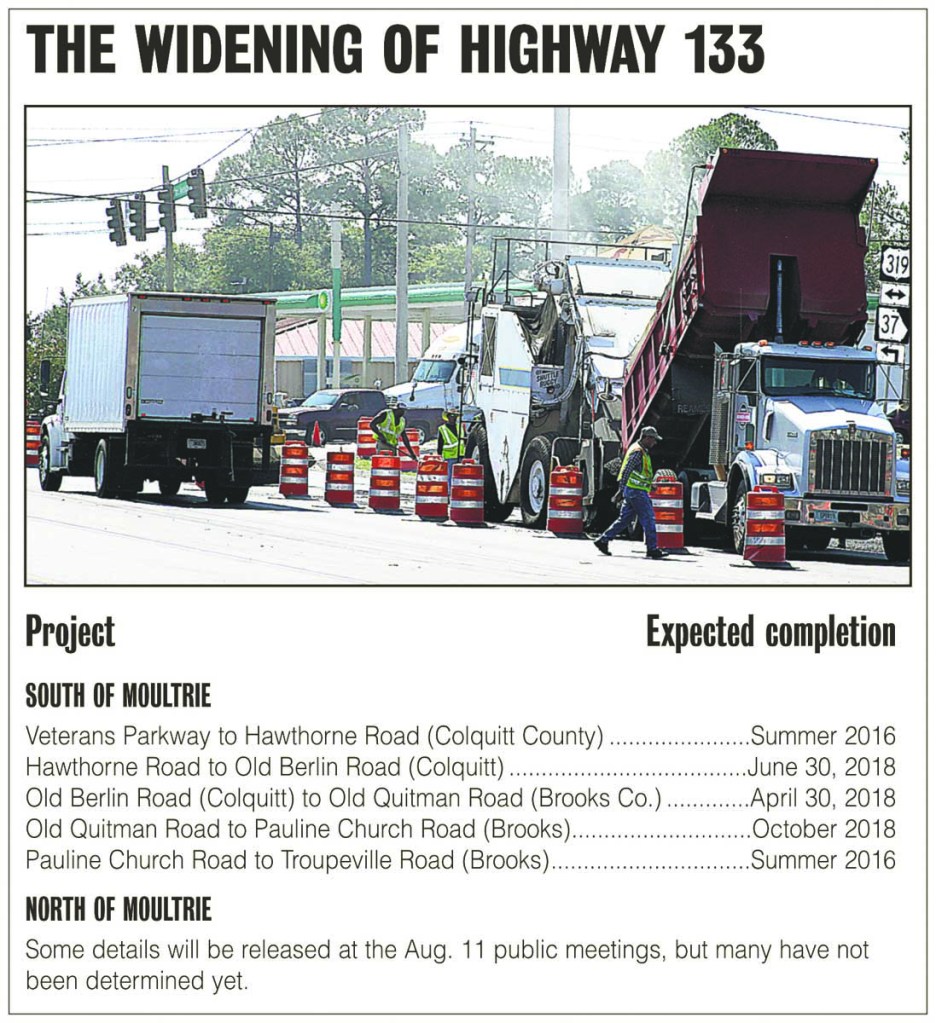Highway 133: First 2 projects completed in 2016
Published 1:00 pm Tuesday, January 3, 2017

- This graphic shows a timeline for the expected completion of five phases of the four-laning of Georgia Highway 133. Each of those phases, from Moultrie to Valdosta, have been bid out and are under construction. Phases from Moultrie to Albany have not been bid, so completion dates have not been announced.
Editor’s Note: This is one of a series of stories looking back at significant progress in Moultrie and Colquitt County during 2016.
MOULTRIE, Ga. — The Georgia Department of Transportation hit two milestones in 2016 with its work on Highway 133: The completion of the first project on the road and the letting of all projects from Moultrie to Valdosta.
Trending
The state highway runs 66 miles from Albany to Valdosta, cutting through Doerun, Moultrie, Berlin and Morven. For most of its length, it’s two lanes with sporadic passing lanes on one side or the other. It’s four lanes through the City of Moultrie, and development officials have been pushing for years to get it four-laned all the way.
The state DOT divided the work into nine projects — four north of Moultrie, one in the city limits and four to the south. The southern-most project was let first and the one in the City of Moultrie shortly thereafter, both in 2013. The Moultrie project was completed in August 2016; the other was scheduled to be done about the same time but received an extension through the end of the year because of weather delays.
Between the beginning and end of the Moultrie project, all of the other southern projects were bid out, and work began on some of them. The winning bid on the last section was announced in early April 2016.
The remaining projects south of Moultrie are expected to be finished at varying times in 2018.
Work north of Moultrie has been hampered by disagreement about how to route the highway in the Doerun area. The two-lane highway runs through the middle of town now, but there isn’t room to build a traditional four-lane in that same space.
Initial plans called for building a bypass around the town, but that met with opposition.
Trending
Another option would make two Doerun streets open to one-way traffic only. North-bound traffic from Moultrie would flow onto Broad Avenue (the current Highway 133), while south-bound traffic from Albany would flow onto Bay Avenue a block away (currently part of Highway 270).
Many Doerun residents attended a meeting in November at which DOT representatives asked them to vote on their preference. The vast majority of those at the meeting prefered coming through town, but it wasn’t clear how big an impact that vote will have on the DOT’s final decision.
The idea of coming through Doerun pretty much was a non-starter when it was thought federal funding would pay for the project, DOT District Program Manager Matt Bennett said during an interview after the public hearing. Now that the project will be state-funded, a change in concept is a possibility.
“In general, federal involvement pushes us to a bypass,” he said. “With the state (paying) we have different options. We had studied a bypass. We’re now looking at downtown again. We’re preparing a through-town route now.”
None of the northern projects have been let for bids. During a public hearing in August, Assistant State Road Design Engineer Chris Rudd said if the bypass option is approved, right-of-way acquisition could begin in six to eight months, and if the through-town option is chosen, it would take a few months longer. Construction is expected to start about 24 months after the right-of-way acquisition, he said.
Colquitt County development officials have looked forward to the four-laning for decades. They hope that by better connecting Moultrie with the larger cities of Albany and Valdosta as well as access to Interstate 75, the county will be better positioned to attract industry that might need that infrastructure for its trucks.
“That’s a big project and would have a huge impact on all these communities when it’s finished,” said Colquitt County Development Authority President Darrell Moore way back in 2008. “Not just all those communities (the highway runs through) but throughout Southwest Georgia. It certainly would lead to more opportunities for us. Any time you have transportation improvements it helps.”
The widening of Highway 133 was the largest project in the region when Georgia considered regional Transportation Special Purpose Local Option Sales Taxes in the summer of 2012. Southwest Georgia was one of many regions that rejected the TSPLOST.
Funding finally began to come through in 2016 after the state Legislature approved a change in the way road projects are funded last year. The increased fuel tax and motel tax were expected to add $760 million in new money for road and bridge projects across the state in its first year.




